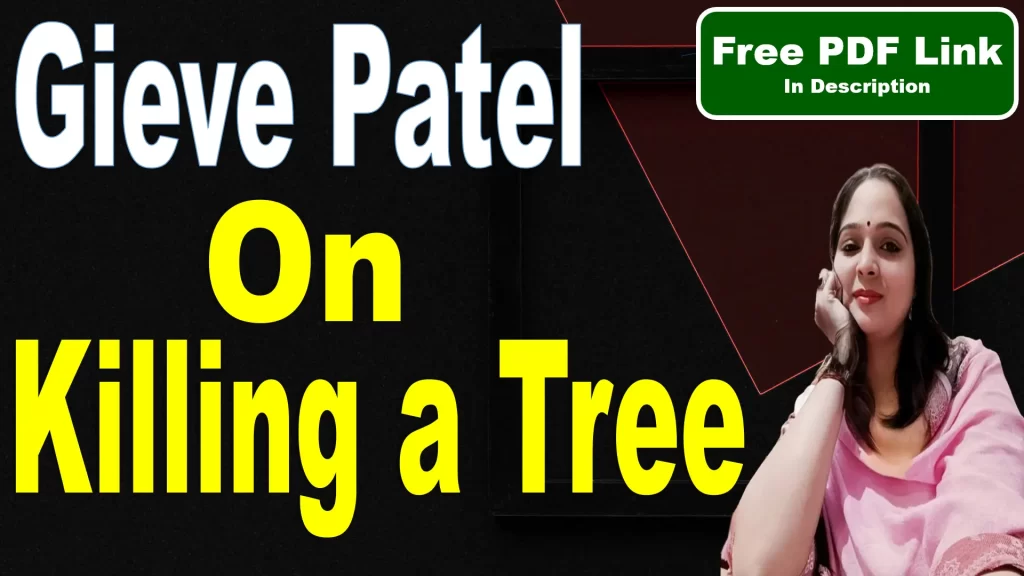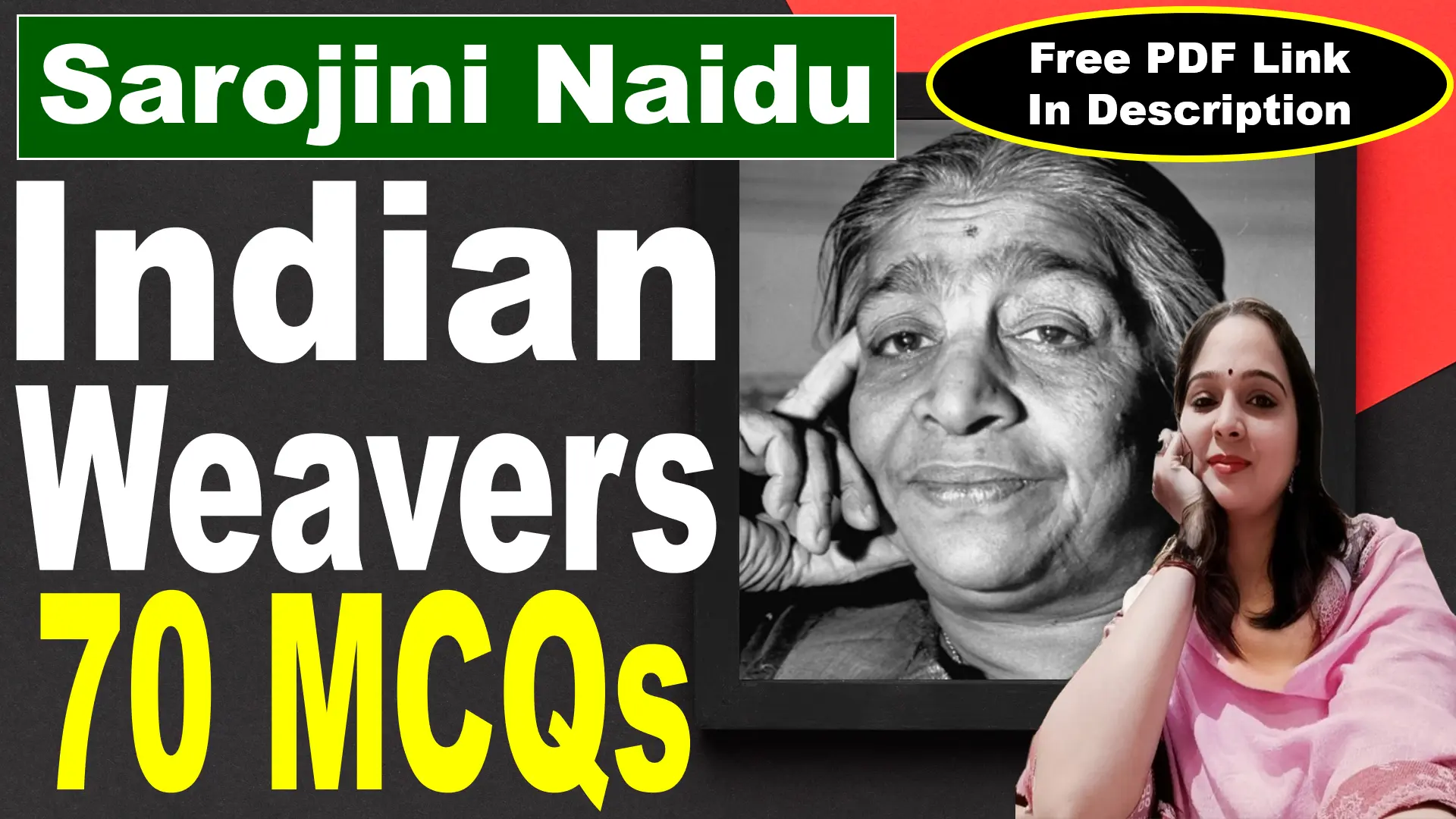
Summary of On Killing a Tree
Gieve Patel, an Indian poet, playwright, painter and physician. He is associated with the “Green Movement” in Indian literature, which focuses on environmental themes. The poem “On Killing a Tree” is taken from Patel’s poetry collection “Poems”, published in 1966 by Nissim Ezekiel in Bombay. Nissim Ezekiel, a prominent Indian poet and critic, played a significant role in promoting Indian English poetry and helped bring Patel’s works to wider recognition.
“On Killing a Tree” is a thought-provoking poem that describes the process of killing a tree and reflects on the resilience of nature. The poet explains that destroying a tree is not a simple task. A mere jab of a knife or superficial injury cannot kill it because the tree has grown strong over the years, deeply rooted in the earth. It has absorbed sunlight, air, and water to become sturdy and full of life.
The poet says that even if the tree is hacked or chopped, it will not die immediately. The “bleeding bark” will heal over time, and new shoots or branches will sprout from the stump. These small twigs, if left unchecked, will grow into a full tree again. This shows the immense strength and persistence of nature.
To completely kill the tree, one must uproot it entirely. The roots, which are the source of the tree’s strength and life, must be pulled out from the earth. The poet describes this as a violent and deliberate process, involving roping, tying, and pulling the roots out of the “earth-cave.” Once the roots are exposed, white and wet, the tree’s vulnerability becomes visible. These roots, hidden for years beneath the soil, are sensitive and crucial for the tree’s survival.
After the tree is uprooted, it is left to dry under the sun and air. Slowly, it starts to wither, twist, and harden. Over time, it turns brown and lifeless, and finally, the process of killing the tree is complete.
The poem uses the tree as a metaphor for resilience and life. It highlights how nature fights back and how difficult it is to destroy something deeply rooted. On a deeper level, it symbolizes the challenges of removing deeply entrenched beliefs or values.
Through this poem, the poet subtly critiques humanity’s destruction of nature, reminding us of its strength and urging us to respect and protect it.
Key Points
Author
Gieve Patel: An Indian poet, playwright, and painter associated with the Green Movement in literature. He was also a doctor (MBBS from Grant Medical College, Bombay). His works often focus on environmental and social themes.
Structure and Form
“On Killing a Tree” by Gieve Patel is written in free verse, with no fixed rhyme scheme or meter in four stanzas.
Speaker
The speaker appears to be an observer who is describing the methodical and violent process of killing a tree. The voice is detached yet critical, reflecting a tone of clinical observation mixed with underlying concern for nature.
Setting
The poem is set in a natural environment, focusing on a tree deeply rooted in the earth. The imagery creates a vivid scene of both the tree’s growth and the process of its destruction.
Theme
Resilience of Nature: The poem highlights the strength and persistence of life, symbolized by the tree.
Human Destruction: It critiques humanity’s insensitivity and destructive tendencies towards the environment.
Interconnectedness: The tree’s reliance on sunlight, water, air, and earth symbolizes nature’s harmony and dependency on its elements.
Persistence of Life: Even when harmed, life strives to regenerate unless completely uprooted.
Plot
The Strength of the Tree: The poet explains that killing a tree is not easy. A tree grows slowly over many years, absorbing nutrients from the earth and essential elements like sunlight, air, and water. Its strength lies in its deep roots and its ability to survive and flourish, even after injuries.
Superficial Damage is Not Enough: Cutting or chopping the tree cannot destroy it completely. Though the tree may be wounded, the bark will heal, and new shoots will grow from the stump. If left unchecked, these shoots will grow back into a full-sized tree. This shows the tree’s ability to regenerate and recover from damage.
The Process of Uprooting: To completely kill the tree, it must be uprooted. The roots, which are hidden deep in the earth and provide the tree with strength and life, need to be pulled out forcefully. This is a difficult and violent process, exposing the sensitive, wet, and white roots that have been protected underground for years.
The Tree’s Final Death: Once uprooted, the tree is left exposed to the sun and air. Over time, it begins to dry out. Its trunk and branches turn brown, harden, twist, and wither. Eventually, the tree dies completely, marking the end of its life.
Tone
Clinical and Matter-of-Fact: The speaker’s tone reflects the deliberate nature of the act of destruction.
Critical and Reflective: Beneath the detachment lies a subtle critique of humanity’s insensitivity to nature.
Somber and Final: The concluding lines emphasize the inevitability and finality of destruction.
Style
Imagery: Vivid descriptions such as “bleeding bark,” “curled green twigs,” and “white and wet” evoke strong visual and sensory impressions.
Personification: The tree is given human-like qualities, such as “bleeding,” “healing,” and “anchoring,” to evoke empathy.
Symbolism: The tree symbolizes resilience and the deep-rooted connections in nature or life.
Enjambment: The continuation of lines reflects the continuous process of destruction and regeneration.
Message
The poem serves as a critique of humanity’s destructive behavior towards nature. It emphasizes the resilience of life and the difficulty of erasing deep-rooted connections, whether in nature or metaphorically in human struggles. Patel urges respect and care for the environment and warns against the consequences of thoughtless destruction.
Gieve Patel: Short Biography
Early Life and Background
Birth: Gieve Patel was born on August 18, 1940, in Mumbai, Maharashtra.
Community: He belonged to the Parsi community, a significant and culturally rich group in India.
Education: Patel pursued medicine at the prestigious Grant Medical College in Mumbai, later practicing as a general physician.
Profession: He balanced his career as a doctor with his pursuits in poetry, painting, and playwriting, practicing medicine until his retirement in 2005.
Contributions to Literature
Patel’s literary works explore themes of urban life, nature, cultural identity, and human anatomy. His dual roles as a physician and a poet heavily influenced his focus on the human body and societal issues.
a) Poetry
Published three major collections of poetry:
Poems (1966) – His debut collection, launched under the mentorship of Nissim Ezekiel, focuses on urban life and personal reflection.
How Do You Withstand, Body (1976) – Explores themes of human vulnerability, mortality, and resilience, drawing from his experiences as a doctor.
Mirrored, Mirroring (1991) – Reflects on nature, self-awareness, and relationships.
Notable Poems:
“On Killing a Tree”: A widely acclaimed work that critiques humanity’s insensitivity toward nature, symbolizing environmental destruction.
“Naryal Purnima”: Examines cultural rituals, societal divides, and self-identity within an urban setting.
b) Plays
Authored three plays, often centered on themes of family, societal pressures, and human relationships:
Princes (1971) – Explores conflicts within a family, highlighting personal and generational struggles.
Savaksa (1982) – Focuses on themes of personal identity and societal expectations.
Mr. Behram (1987) – A commentary on the complexities of life in the Parsi community.
c) Prose
Patel also wrote essays and commentaries, blending personal observations with broader socio-political themes.
Contributions to Art
Patel was a highly respected painter, known for his works that depicted the complexities of contemporary life and social realities.
First Solo Exhibition: Held in Mumbai in 1966, marking the beginning of a prolific art career.
Style and Themes: His paintings often focused on human vulnerability, urban struggles, and societal inequalities.
Exhibited his work internationally, gaining recognition as a multi-faceted artist.
Advocacy for Environmentalism
Gieve Patel was actively involved in the Green Movement and used his poetry and art to raise awareness about environmental protection.
His works, like “On Killing a Tree,” emphasize humanity’s responsibility toward nature and critique ecological destruction.
Mentorship and Influence
Mentored by Nissim Ezekiel, a pioneering figure in Indian English poetry, who played a crucial role in launching his literary career.
Patel himself became a mentor to emerging poets and artists, influencing subsequent generations in Indian English literature and contemporary art.
Personal Philosophy and Style
Known for his minimalist yet evocative style, Patel blended personal reflection with broader societal critique.
His works frequently juxtapose urban modernity with traditional values, exploring themes of survival, inequality, and identity.
He often drew from his medical background to explore themes of mortality, the human body, and resilience.
Legacy and Recognition
Gieve Patel’s works are considered a cornerstone of Indian English literature, known for their authenticity and depth.
His poetry, particularly “On Killing a Tree,” is part of school and college syllabi in India, ensuring that his legacy reaches younger generations.
As an artist, he holds a significant position in contemporary Indian art, with his works displayed in major galleries across the world.
Death
Gieve Patel passed away on November 3, 2023, in Pune, Maharashtra, at the age of 83.
His multifaceted contributions to literature, art, and society continue to inspire readers, writers, and artists.
Word Meaning
| Tough Word | Meaning in English | Meaning in Hindi |
| jab | A quick and sharp blow or poke | चुभन या तेज वार |
| crust | The outer layer or surface of something | बाहरी परत |
| absorbing | Taking in or soaking up | अवशोषित करना |
| leprous | Rough, scaly, or diseased-looking | खुरदरा या रोगग्रस्त दिखने वाला |
| sprouting | Beginning to grow or develop | अंकुरित होना |
| hack and chop | To cut roughly or violently | काटना और चीरना |
| bleeding bark | Sap flowing out of a tree when it is injured | पेड़ से रिसता हुआ रस |
| curled | Bent into a curved shape | मुड़ा हुआ |
| twigs | Small, thin branches | पतली छोटी शाखाएं |
| miniature | Very small or tiny | बहुत छोटा |
| boughs | Main branches of a tree | मुख्य शाखाएं |
| former | Earlier or previous | पहले का |
| pulled out | Removed by pulling | खींचकर बाहर निकालना |
| anchoring earth | Soil holding something firmly in place | वह मिट्टी जो किसी चीज़ को थामे रखती है |
| roped | Secured or tied with a rope | रस्सी से बांधना |
| snapped out | Pulled out suddenly | झटके से खींचकर निकालना |
| earth-cave | Underground space where roots are embedded | जड़ें जहाँ गहराई तक जमी होती हैं |
| matter | Substance or material | पदार्थ |
| scorching | Burning intensely | झुलसाना |
| choking | Suffocating or obstructing air | घुटन या हवा रोकना |
| twisting | Bending or turning in an irregular way | मरोड़ना |
| withering | Drying up and decaying | मुरझाना |





